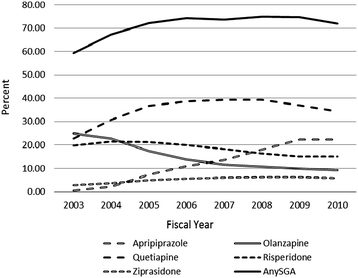Patterns of initiation of second generation antipsychotics for bipolar disorder: a month-by-month analysis of provider behavior
- PMID: 25433807
- PMCID: PMC4256839
- DOI: 10.1186/s12888-014-0339-z
Patterns of initiation of second generation antipsychotics for bipolar disorder: a month-by-month analysis of provider behavior
Abstract
Background: Several second generation antipsychotics (SGAs) received FDA approval for bipolar disorder in the 2000s. Although efficacious, they have been costly and may cause significant side effects. Little is known about the factors associated with prescribers' decisions to initiate SGA prescriptions for this condition.
Methods: We gathered administrative data from the Department of Veterans Affairs on 170,713 patients with bipolar disorder between fiscal years 2003-2010. Patients without a prior history of taking SGAs were considered eligible for SGA initiation during the study (n =126,556). Generalized estimating equations identified demographic, clinical, and comorbidity variables associated with initiation of an SGA prescription on a month-by-month basis.
Results: While the number of patients with bipolar disorder using SGAs nearly doubled between 2003 and 2010, analyses controlling for patient characteristics and the rise in the bipolar population revealed a 1.2% annual decline in SGA initiation during this period. Most medical comorbidities were only modestly associated with overall SGA initiation, although significant differences emerged among individual SGAs. Several markers of patient severity predicted SGA initiation, including previous hospitalizations, psychotic features, and a history of other antimanic prescriptions; these severity markers became less firmly linked to SGA initiation over time. Providers in the South were somewhat more likely to initiate SGA treatment.
Conclusions: The number of veterans with bipolar disorder prescribed SGAs is rising steadily, but this increase appears primarily driven by a corresponding increase in the bipolar population. Month-by-month analyses revealed that higher illness severity predicted SGA initiation, but that this association may be weakening over time.
Figures


Similar articles
-
The Ascendancy of Second-Generation Antipsychotics as Frontline Antimanic Agents.J Clin Psychopharmacol. 2015 Dec;35(6):645-53. doi: 10.1097/JCP.0000000000000405. J Clin Psychopharmacol. 2015. PMID: 26488678
-
Off-label use of second generation antipsychotics for post-traumatic stress disorder in the Department of Veterans Affairs: time trends and sociodemographic, comorbidity, and regional correlates.Pharmacoepidemiol Drug Saf. 2014 Jan;23(1):77-86. doi: 10.1002/pds.3507. Epub 2013 Aug 31. Pharmacoepidemiol Drug Saf. 2014. PMID: 23996688
-
Off-Label Prescribing of Second-Generation Antipsychotics to Elderly Veterans with Posttraumatic Stress Disorder and Dementia.J Am Geriatr Soc. 2017 Aug;65(8):1789-1795. doi: 10.1111/jgs.14897. Epub 2017 Apr 3. J Am Geriatr Soc. 2017. PMID: 28369688
-
Efficacy and safety of second-generation antipsychotics in children and adolescents with psychotic and bipolar spectrum disorders: comprehensive review of prospective head-to-head and placebo-controlled comparisons.Eur Neuropsychopharmacol. 2011 Aug;21(8):621-45. doi: 10.1016/j.euroneuro.2010.07.002. Epub 2010 Aug 10. Eur Neuropsychopharmacol. 2011. PMID: 20702068 Review.
-
[Antipsychotics in bipolar disorders].Encephale. 2004 Sep-Oct;30(5):417-24. doi: 10.1016/s0013-7006(04)95456-5. Encephale. 2004. PMID: 15627046 Review. French.
Cited by
-
International Trends in Lithium Use for Pharmacotherapy and Clinical Correlates in Bipolar Disorder: A Scoping Review.Brain Sci. 2024 Jan 20;14(1):102. doi: 10.3390/brainsci14010102. Brain Sci. 2024. PMID: 38275522 Free PMC article.
-
Does screening for PTSD lead to VA mental health care? Identifying the spectrum of initial VA screening actions.Psychol Serv. 2023 Aug;20(3):525-532. doi: 10.1037/ser0000651. Epub 2022 Apr 21. Psychol Serv. 2023. PMID: 35446094 Free PMC article.
References
Publication types
MeSH terms
Substances
LinkOut - more resources
Full Text Sources
Other Literature Sources
Medical

